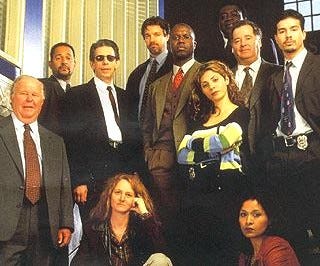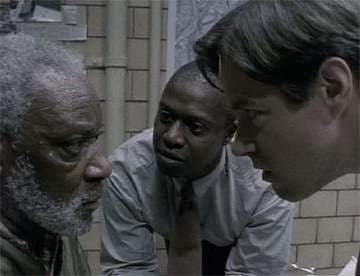W.G.H
“Bayliss: So are you going to interrogate him?
Pembleton: Interrogate him?
Bayliss: Yeah, yeah. I’m just saying. You know, not a partner thing but when you interrogate him I’d like to sit in.
Pembleton: Then what you will be privileged to witness will not be an interrogation, but an act of salesmanship. As silver-tongued and thieving as ever moved used cars, Florida swamp land, or Bibles. But what I am selling is a long prison term to a client who has no genuine use for the product. {he heads for the box}
Bayliss: I guess that’s a yes.”
The first TV series I remember that caught my attention was “The six million dollar man”, or as we lovingly referred to it in Israel – Steve Austin. Then came “Little house in the prairie” and our first color TV set. I loved TV and watch quite a few series very closely, but the one that caught me by surprise and blew my mind was “Homicide: Life on the street”.
I had a night job at the time. A lot of time on my hands, and while I did have schoolwork to do (I was attending college at the time), I couldn’t bring myself to dedicate the whole night to typing on my 500 Kg laptop for 8 hours.
Luckily, an old TV was stationed in front of me, and Friday nights featured a feature films. One of these Friday evenings as best as I can remember, I clicked the remote and what I saw on the screen was an opening sequence to a show I’ve never seen before.
I found myself staring at something I couldn’t really define, but I knew that it was something completely new. I had no knowledge of the production team, and of course no backstage intel, but I felt that what I was watching was slightly rebellious, not to mention revolutionary (Though that realization would come a few episodes in).
Obviously’ it’s a police show, right? Detectives, crimes, a scary boss. One expects a certain flow to the show. A murder is presented, the detectives show up and investigation ensues, followed by a couple of twists and turns, ending in a confession or conviction.
The thing was, expectations were subtly subverted.
Although it is a bit obvious who the lead characters are… was it? Tim Bayliss and Frank Pembleton seems to be the pairing, around which the series is written. But a large portion of screen time is invested in unveiling the rest of the shift, as well as other characters.
What about the plots? Well, as far as police investigation goes, little to no makeup was applied on the characters and what they represented. The show was no Police department PR piece. The good and the shoddy policework were what they were – part of life on the street. Corruption and compassion, Cynicism and heartfelt empathy, the whole package, on screen. And perhaps more importantly, success and failure. Not all crimes are solved, and that’s that.
As the episodes rolled on, one of the series’ greatest strengths emerged. This was not a show about crime. It was a police detective show about detectives. People. And the focus on the dialog, rather than the non-existent car chases and gun fights, made it uniquely relatable.
Handheld cameras, minimal framing and certain decisions (such as to ignore background noises and others), made the experience riveting. Along with great musical choices, this made a dialog heavy series feel very dynamic. Black and while footage, Color saturation and other simple technical devices, helped give the show a look of it’s own. All due respect, this was not Hill street Blue or NYPD Blue. The minute you see the first frame on the screen, you know it’s “Homicide”.
The scripts were brave, and touched on topics that were far from mainstream, even for the 90s. Characters were allowed to be flawed. Hints of racism, chauvinism, and all the “phobias” which later were taken to the extreme, although they reside in every one of us, less-than-perfect individuals, were featured. It’s about the honesty of the writers. A long forgotten trait…
The show featured multiple layered and interesting characters, but if we look at each and every one of them, it might require a series of posts. Instead, let’s focus on the obvious two. The “thinkers”, as they would be referred to later, by the character of Detective Falsone:
Frank Pembleton (my overall MVP of the series), played by the great, Late Andre Braugher, was the legendary detective who was revered and feared by most of his colleagues. An independent guy, who had to pick up a rookie homicide detective and get on a tragic investigation, just to kick things off.
Frank moved on the spectrum of religious faith, strong ingrained values and a holistic view of police and homicide work. Braugher brought a masterclass of human studies to his performances, and enjoyed writing (both an arch as well as dialog) that I’m hard pressed to find a match for.
Alongside him, Kyle Secor played Detective Tim Bayliss (aforementioned rookie), who looks up to Frank to start, and they embark on an emotional rollercoaster throughout the series. Bayliss is an ideolog who wants to understand, and is the negative image of Pembleton’s efficient “let’s put the criminals behind bars” whatever the reason for the crime may be. This, of course is contrasted by Tim’s desire to succeed as a detective and earn Frank’s respect on the one hand, and Pembleton’s internal struggles and his ability to “get in the head of the criminal” on the other.
Simply phenomenal character creation, and that extends to the rest of the cast.
Here, perhaps for the first time (surely the first I’ve seen), the city in which the stories take place is an actual character. When one thinks about “Homicide: Life on the street”, one thinks about Baltimore and visa versa (We’ll get back to Ball-a-more later). Part of it is due to the conscious decision and writing of the show, and another is the integration of its surroundings in the visual and audible presence. Scenes are shot on location, in any kind of weather. People crosses cameras, sounds get caught on the reels. The city lives in the show, including its trademark foods and culture.
All of the above created, at least for me – and I know for a fact I’m far from being the only one – a strong connection to the stories and the characters. I literally couldn’t wait for the next episode. I absolutely loved Bayliss and Pembleton. I waited for every interaction involving Lieutenant Giardello. Later on, I was fascinated by the humanity of Mike Kellerman and so on. The characters’ trials and tribulations felt real, and I really felt for them.
In some cases, it takes a series a long time to get to one of those seminal episodes that defines it and serve as a tour de force. For “Homicide”, it took no more than five.
Three men and Adena was to TV, what Reservoir Dogs was to Films.
The bravery of the decision to even do the episode, is commendable. A frames play, essentially, within the very first season of a new show, featuring basically three characters in one room. Outstanding performances by both detectives, as well as the suspect. The link to the emotionally charged case of a murdered girl. Everything about this episode was done in a way we weren’t used to on TV, let alone on a “police procedural”. I didn’t need this episode to buy-in on the series, but thank God it was made.
The series as a whole was great, but for a while it impacted me in a way that perhaps prevented me from finding other shows to enjoy. Sure, I liked the X Files and watched a series or another here and there, but “Homicide” was such a high and mighty measuring stick for me, I didn’t give TV much of a chance for a while. I mean, how could anything stand up to this?
“Homicide” and its makers, brought us additional quality products. Oz, was a great series that again, broke the mold, but it was definitely “The Wire” which brought us back home to Baltimore, for what became in my humble opinion, one of TV’s top 3 series ever. Take “Homicide: Life on the street” and all of it’s inherent experience and then zoom way out, and you have a once-in-a-lifetime presentation of police work, crime, politics and… Life on the street. Mixed in, the same phenomenal character work and sharp, honest writing, delivered by an amazing cast.
All of that started in the early 90s, on the show that blew my mind.
So that was me. Now, it’s your turn:
What was the first show that blew your mind? Why?
If it was “Homicide: Life on the street”, I’d love to read your perspectives. Comments, likes and shares are not frowned upon in these parts, and if you’re interested to feature a full on post right here, let me know and perhaps we can make that happen too.







